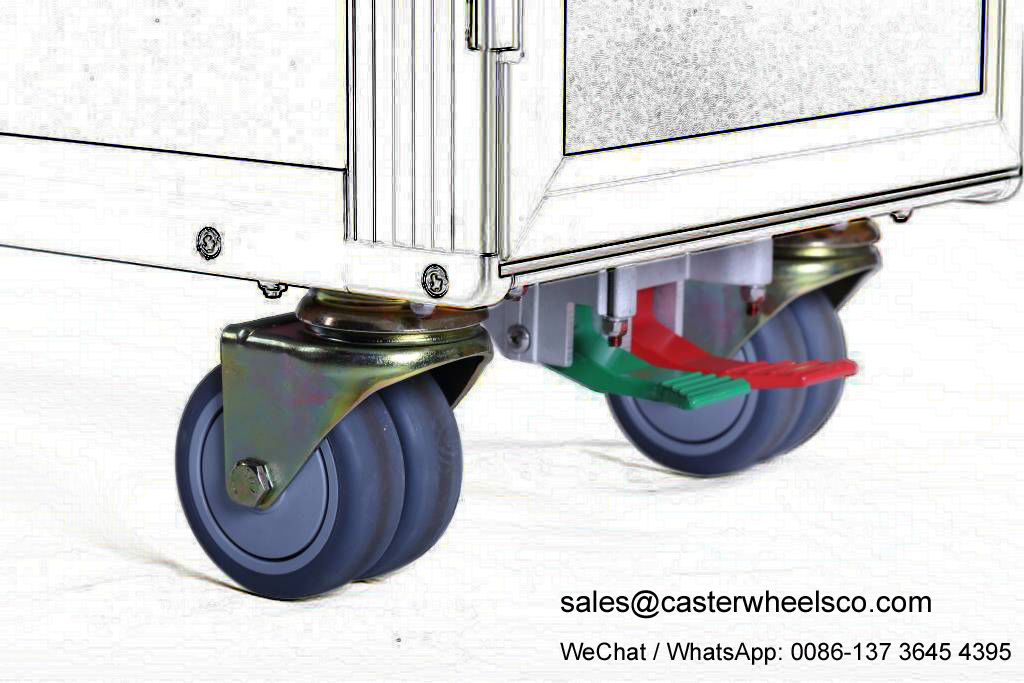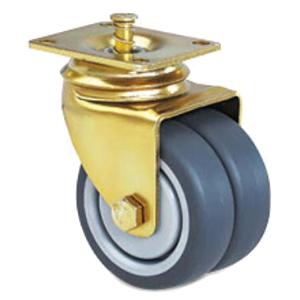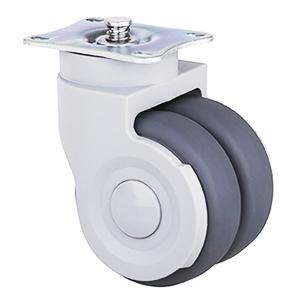Different between airline trolley casters and common trolley casters
Airline trolley casters and common trolley casters are two types of caster wheels used in different applications. While they share some similarities, they also have distinct differences in design, construction, materials, functionality, and performance. In this article, we will explore these differences in detail.
Design and Construction:
Airline trolley casters are specifically designed for use in airline catering carts or trolleys. These carts are used by flight attendants to serve food, beverages, and other items to passengers during flights. Airline trolley casters are often compact and lightweight to ensure ease of maneuverability in tight spaces such as aircraft aisles and galley areas. They are typically made from materials like nylon, plastic, or rubber to minimize weight while providing sufficient load-bearing capacity.
Common trolley casters, on the other hand, are designed for a wide range of applications, including industrial, commercial, and residential use. They come in various sizes, designs, and materials to cater to different load capacities, environments, and specific requirements. Common trolley casters can be made from materials like steel, cast iron, rubber, or polyurethane, depending on the intended application and load-bearing capacity needed.
Load Capacity and Performance:
Airline trolley casters are generally designed to handle relatively lighter loads compared to common trolley casters. The weight of catering carts with all the food and beverage items loaded onto them is generally within a certain range, and the casters are designed to support that specific weight limit. The focus is on providing smooth rolling and maneuverability in aircraft cabin environments.
Common trolley casters, on the other hand, come in a wide range of load capacities, from light-duty to heavy-duty options. They are designed to handle various loads and are often selected based on the specific application requirements. Heavy-duty casters are typically used in industrial settings where they need to withstand large loads and rough terrains.
Wheel Materials:
Airline trolley casters often have wheels made from materials like nylon or rubber. These materials offer smooth and quiet rolling, which is essential in aircraft cabins where noise levels need to be minimized. The wheels are designed to be non-marking to prevent damage to the aircraft's flooring. Additionally, some airline trolley casters may have non-static properties to reduce the risk of electrostatic discharge in sensitive aircraft environments.
Common trolley casters, on the other hand, come with a wider range of wheel material options. These can include polyurethane, rubber, steel, or cast iron, depending on the specific application requirements. Each material offers unique properties such as high load capacity, shock absorption, chemical resistance, or heat resistance, allowing for customization based on the intended use.
Braking Mechanisms:
Airline trolley casters often incorporate braking mechanisms to ensure stability and safety during flight operations. These brakes are designed to securely lock the casters in place, preventing the trolleys from moving or rolling unintentionally. Braking systems in airline trolley casters are typically lightweight and easy to engage and disengage, allowing flight attendants to secure the carts quickly and efficiently.
Common trolley casters also offer a wide range of braking mechanisms, including swivel locks, side brakes, top plate brakes, or total lock brakes. These braking options provide varying levels of stability and control, depending on the specific application. Industrial applications, for example, may require heavy-duty locking mechanisms to secure heavy loads in place.

Swivel and Mounting Options:
Airline trolley casters often feature swivel mechanisms that allow for easy maneuvering and navigation around tight corners and narrow aisles in aircraft cabins. These swivel options provide enhanced mobility and flexibility to flight attendants while serving passengers. Airline trolley casters also typically come with a specific mounting configuration that is compatible with the trolley design and structure.
Common trolley casters offer a wide range of swivel and mounting options to cater to different applications. Swivel options can include single or double ball bearings, precision swivel races, or maintenance-free swivel heads. Mounting configurations can vary from top plate mounts to stem mounts, allowing for easy installation on various types of trolleys and equipment.
Environment and Regulations:
Airline trolley casters need to meet specific regulations and standards set by aviation authorities to ensure safe operation in aircraft cabins. These regulations often include requirements for noise levels, fire resistance, non-marking properties, and electrostatic discharge prevention. Airline trolley casters must comply with these regulations to ensure compatibility with the aircraft environment and to minimize any potential risks.
Common trolley casters, on the other hand, are not subject to such specific regulations unless they are used in specialized industries or environments that have specific requirements. For example, casters used in the healthcare industry may need to meet certain hygiene standards or have antimicrobial properties to prevent the spread of infections.
Cost and Availability:
Airline trolley casters are often more specialized and may be more expensive compared to common trolley casters. The specific design considerations, materials, and compliance with aviation regulations contribute to their higher cost. Additionally, airline trolley casters may have limited availability in the market due to their niche application.
Common trolley casters, being widely used across different industries and applications, are generally more readily available and cost-effective. They benefit from economies of scale, making them a cost-efficient choice for applications that do not require the specialized features of airline trolley casters.
In conclusion, airline trolley casters and common trolley casters differ significantly in terms of design, load capacity, wheel materials, braking mechanisms, swivel and mounting options, regulatory compliance, cost, and availability. Airline trolley casters are specifically designed for aircraft catering trolleys, emphasizing lightweight construction, smooth rolling, braking systems, and compliance with aviation regulations. Common trolley casters, on the other hand, are versatile and cater to a wide range of applications, offering various load capacities, wheel materials, braking options, and mounting configurations. Understanding these differences is crucial when selecting the appropriate caster for specific applications, ensuring efficient and safe operations.



 English
English Spanish
Spanish German
German Russian
Russian Arabic
Arabic Portuguese
Portuguese Italian
Italian French
French Hebrew
Hebrew Turkish
Turkish